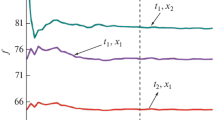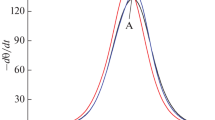Abstract
We discuss some properties of the one-dimensional Fokker-Planck equation, and in particular the time required to go through a potential barrier of arbitrary size and shape. We apply the resulting formulas to the melting of helical polymers made of two types of monomers (A and B) with different melting temperatures: We consider a restricted problem in irreversible melting, where onesingle boundary (separating a coil region from a helical region) moves through the chemical sequence. In a crude approximation the distribution function for the boundary point is then ruled by a simple Fokker-Planck equation. When the temperatureT is equal to or higher than the average melting point¯T, the boundary tends to move over macroscopic distances, thus extending the size of the coil regions. In an interval¯T<T<T * the progression is predicted to be slow (logarithmic). At higher temperatureT>T * essentially all barriers are overcome and the progression is fast.
Similar content being viewed by others
References
T. Birshtein and O. Ptitsyn,Conformations of Macromolecules, Interscience, New York (1966), Chapter 9–11. D. Poland and H. Scheraga,Theory of Helix Coil Transitions, Academic Press, New York (1970).
E. W. Montroll and N. S. Goel,Biopolymers 4:855 (1966);6:731 (1968).
A. Vedenov and A. Dykne,Soviet Phys. — JETP 28:187 (1969); B. Y. Tong and S. Y. Tong,J. Chem. Phys. 54:1317 (1971).
M. Ya. Azbel,Biopolymers 12:1591 (1973).
G. Schwartz,J. Mol. Biol. 11:64 (1965).
P. G. De Gennes,J. Chim. Phys. (Paris) (1967).
H. A. Kramers,Physica 7:284 (1940).
P. G. De Gennes,Comm. Sol. State Phys. II:149 (1969).
S. Falkow and D. B. Cowie,J. Bacteriol. 96:777 (1968); G. Bernardi, M. Faures, G. Piperno, and P. P. Slonimski,J. Mol. Biol. 48:23 (1970).
C. Reiss, Melting ofλ is only locally cooperative,Biopolymers, to appear.
C. Reiss, Thermal transition spectroscopy of nucleic acids. IV. Sequence mapping,Biopolymers, in press; F. Michel,J. Mol. Biol. (1974), in press.
C. Reiss, private communication.
Author information
Authors and Affiliations
Rights and permissions
About this article
Cite this article
De Gennes, P.G. Brownian motion of a classical particle through potential barriers. Application to the helix-coil transitions of heteropolymers. J Stat Phys 12, 463–481 (1975). https://doi.org/10.1007/BF01025834
Received:
Issue Date:
DOI: https://doi.org/10.1007/BF01025834




